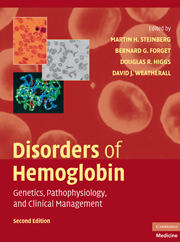Book contents
- Frontmatter
- Contents
- List of Contributors
- Foreword, by H. Franklin Bunn
- Preface
- Introduction, by David J. Weatherall
- SECTION ONE THE MOLECULAR, CELLULAR, AND GENETIC BASIS OF HEMOGLOBIN DISORDERS
- SECTION TWO PATHOPHYSIOLOGY OF HEMOGLOBIN AND ITS DISORDERS
- SECTION THREE α THALASSEMIA
- 13 The Molecular Basis of α Thalassemia
- 14 The Pathophysiology and Clinical Features of α Thalassaemia
- 15 Unusual Types of α Thalassemia
- SECTION FOUR THE β THALASSEMIAS
- SECTION FIVE SICKLE CELL DISEASE
- SECTION SIX OTHER CLINICALLY IMPORTANT DISORDERS OF HEMOGLOBIN
- SECTION SEVEN SPECIAL TOPICS IN HEMOGLOBINOPATHIES
- SECTION EIGHT NEW APPROACHES TO THE TREATMENT OF HEMOGLOBINOPATHIES AND THALASSEMIA
- Index
- Plate section
- References
15 - Unusual Types of α Thalassemia
from SECTION THREE - α THALASSEMIA
Published online by Cambridge University Press: 03 May 2010
- Frontmatter
- Contents
- List of Contributors
- Foreword, by H. Franklin Bunn
- Preface
- Introduction, by David J. Weatherall
- SECTION ONE THE MOLECULAR, CELLULAR, AND GENETIC BASIS OF HEMOGLOBIN DISORDERS
- SECTION TWO PATHOPHYSIOLOGY OF HEMOGLOBIN AND ITS DISORDERS
- SECTION THREE α THALASSEMIA
- 13 The Molecular Basis of α Thalassemia
- 14 The Pathophysiology and Clinical Features of α Thalassaemia
- 15 Unusual Types of α Thalassemia
- SECTION FOUR THE β THALASSEMIAS
- SECTION FIVE SICKLE CELL DISEASE
- SECTION SIX OTHER CLINICALLY IMPORTANT DISORDERS OF HEMOGLOBIN
- SECTION SEVEN SPECIAL TOPICS IN HEMOGLOBINOPATHIES
- SECTION EIGHT NEW APPROACHES TO THE TREATMENT OF HEMOGLOBINOPATHIES AND THALASSEMIA
- Index
- Plate section
- References
Summary
INTRODUCTION
In this chapter we describe three relatively rare, clinically complex syndromes in which the occurrence of α thalassemia provided the clue to understanding the molecular basis of each condition. These conditions exemplify the important interplay between clinical observation and human molecular genetics. Two of these syndromes (ATR-16 [OMIM: 141750] and ATR-X [OMIM: 301040]) in which α thalassemia is associated with multiple developmental abnormalities (including mental retardation, MR) are inherited. The third condition (ATMDS [OMIM: 300448]) is an acquired disorder in which α thalassemia appears for the first time in the context of myelodysplasia.
α THALASSEMIA ASSOCIATED WITH MENTAL RETARDATION AND DEVELOPMENTAL ABNORMALITIES
The rare association of α thalassemia and mental retardation (MR) was recognized more than 25 years ago by Weatherall and colleagues. It was known that α thalassemia arises when there is a defect in the synthesis of the α-globin chains of adult hemoglobin (HbA, α2β2). When these authors encountered three mentally retarded children with α thalassemia and a variety of developmental abnormalities, their interest was stimulated by the unusual nature of the α thalassemia. The children were of northern European origin, where α thalassemia is uncommon, and although one would have expected to find clear signs of this inherited anemia in their parents, it appeared to have arisen de novo in the affected offspring. It was thought that the combination of α thalassemia with MR (ATR), and the associated developmental abnormalities represented a new syndrome and that a common genetic defect might be responsible for the diverse clinical manifestations.
- Type
- Chapter
- Information
- Disorders of HemoglobinGenetics, Pathophysiology, and Clinical Management, pp. 296 - 320Publisher: Cambridge University PressPrint publication year: 2009
References
- 1
- Cited by



